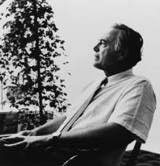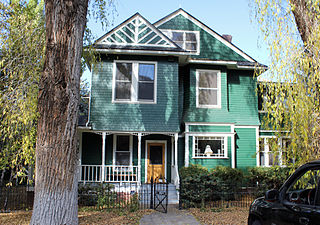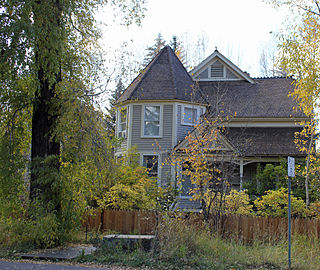
The City of Aspen is the home rule municipality that is the county seat and the most populous municipality of Pitkin County, Colorado, United States. The city population was 7,004 at the 2020 United States Census. Aspen is in a remote area of the Rocky Mountains' Sawatch Range and Elk Mountains, along the Roaring Fork River at an elevation just below 8,000 feet (2,400 m) above sea level on the Western Slope, 11 miles (18 km) west of the Continental Divide. Aspen is now a part of the Glenwood Springs, CO Micropolitan Statistical Area.
Herbert Bayer was an Austrian and American graphic designer, painter, photographer, sculptor, art director, environmental and interior designer, and architect. He was instrumental in the development of the Atlantic Richfield Company's corporate art collection until his death in 1985.

The Aspen Music Festival and School (AMFS) is a classical music festival held annually in Aspen, Colorado.
The Aspen Institute is an international nonprofit organization founded in 1949 as the Aspen Institute for Humanistic Studies. The Institute and its international partners promote the creation of a free, just, and equitable society in a nonpartisan and nonideological setting through seminars, policy programs, conferences, and leadership development initiatives. The institute is headquartered in Washington, D.C., United States, and has campuses in Aspen, Colorado, and near the shores of the Chesapeake Bay at the Wye River in Maryland. It has partner Aspen Institutes in Berlin, Rome, Madrid, Paris, Lyon, Tokyo, New Delhi, Prague, Bucharest, Mexico City, and Kyiv, as well as leadership initiatives in the United States and on the African continent, India, and Central America.
Walter Paepcke was a U.S. industrialist and philanthropist prominent in the mid-20th century. A longtime executive of the Chicago-based Container Corporation of America, Paepcke is best noted for his founding of the Aspen Institute and the Aspen Skiing Company in the early 1950s, both of which helped transform the town of Aspen, Colorado into an international resort destination and popularize the sport of skiing in the United States.

Harry Mohr Weese was an American architect who had an important role in 20th century modernism and historic preservation. His brother, Ben Weese, is also a renowned architect.

Ellis Fuller Lawrence was an American architect who worked primarily in the U.S. state of Oregon. In 1914, he became the co-founder and first dean of the University of Oregon's School of Architecture and Allied Arts, a position he held until his death.
Benjamin Horace (Ben) Weese in Evanston, Illinois is an American architect hailing from Chicago, and a member of the architects group, the Chicago Seven. Weese is the younger brother of Chicago architect Harry Weese.

The John J. Glessner House, operated as the Glessner House, is an architecturally important 19th-century residence located at 1800 S. Prairie Avenue, Chicago, Illinois. It was designed in 1885–1886 by architect Henry Hobson Richardson and completed in late 1887. The property was designated a Chicago Landmark on October 14, 1970. The site was listed in the National Register of Historic Places on April 17, 1970, and as a National Historic Landmark on January 7, 1976.
Robert Bruegmann is an historian of architecture, landscape and the built environment. He is a professor at the University of Illinois at Chicago, and a specialist on the Chicago school of architecture. Bruegmann is best known for his research on the architectural firm of Holabird & Root, and is also a commentator on urban sprawl.
Joe A. Porter is a professional landscape architect and Fellow of the American Society of Landscape Architects. Porter has worked with new community, natural resource, and resort developers to advance the art of community development through design. In 1969 Porter co-founded Design Workshop, a firm practising landscape architecture, land planning, urban design and tourism planning. He is an adjunct professor in the graduate program in landscape architecture at the University of Colorado and frequently speaks at conferences and universities on community development and sustainability issues.

Pioneer Park, also known as the Henry Webber House or the Webber–Paepcke House, is located on West Bleeker Street in Aspen, Colorado, United States. It is a brick structure erected in the 1880s, one of the few such homes in the city. In 1987 it was listed on the National Register of Historic Places.

The Wheeler–Stallard House is located on West Bleeker Street in Aspen, Colorado, United States. It is an 1880s brick structure built in the Queen Anne architectural style, and renovated twice in the 20th century. In 1975 it was listed on the National Register of Historic Places.

The Davis Waite House is located on West Francis Street in Aspen, Colorado, United States. It is a wooden structure in Victorian architectural styles built during the 1880s. In 1987 it was listed on the National Register of Historic Places along with several other historic properties in the city.

The Newberry House, also known as the Judge Shaw House, is located on Lake Avenue in Aspen, Colorado, United States. It is a wooden structure in the Shingle Style built around 1890. In 1987 it was listed on the National Register of Historic Places along with other properties in the city.

The Shilling–Lamb House, also sometimes referred to as Victoria House, is located on North Second Street in Aspen, Colorado, United States. It is a wood frame structure in the Queen Anne architectural style built around 1890. In 1987 it was listed on the National Register of Historic Places.

Founded in 2005, the Aspen Ideas Festival (AIF) is a week-long event held in Aspen, Colorado in the United States. The Aspen Ideas Festival program of events includes discussions, seminars, panels, and tutorials from journalists, designers, innovators, politicians, diplomats, presidents, judges, musicians, artists, and writers.

The Charles N. Ramsey and Harry E. Weese House is a historic residence in Kenilworth, Illinois. Considered an excellent local example of an American Foursquare design, it is also the childhood home of architect Harry M. Weese.
Elizabeth Paepcke was a philanthropist and promoter of Aspen, Colorado. She was born near Baltimore, Maryland.

Aspen Meadows is a 40-acre conference center and resort located amongst the Rocky Mountains in Aspen, Colorado. It is owned by the Aspen Institute, operated by Dolce Hotels and Resorts, and is the venue for some of the institute's most notable events, such as the annual Aspen Ideas Festival and Socrates Program seminars. It was designed by Herbert Bayer in the Bauhaus style.















